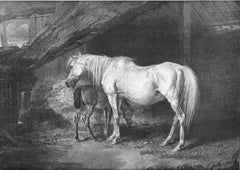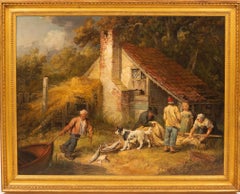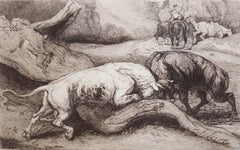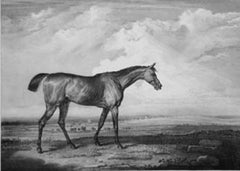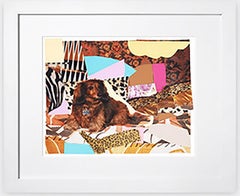Mickalene Thomas
Portrait de Priscilla Le Petit Chien, 2012
Pigment print on 100% cotton rag paper
Edition 148/150
Frame included with official COA affixed to the back
Hand numbered from the edition of only 150 with plate signed official Certificate of Authenticity on the verso of the frame.
This exquisite print, published in 2012, is based on an original collage made by the artist of her long-haired miniature dachshund (a gift from fellow artist Kehinde Wiley), Priscilla. Highly acclaimed contemporary art star Mickalene Thomas created this collage specifically for children- though adults will appreciate it as well - as will pet lovers!
Portrait de Priscilla Petit Chien features Priscilla, Thomas' own dog who frequently attends the artist's photoshoots. This limited edition archival pigment print is printed on cotton rag paper and accompanied by a plate (facsimile) signed and uniquely hand numbered certificate of authenticity. It is matted and comes in a 1"-deep wooden frame with Plexiglas®. Wired for hanging. Edition of 150. This professionally framed limited edition pigment print on 100% cotton rag paper is based on an original collage made by the artist of her long-haired miniature dachshund (a gift from fellow artist Kehinde Wiley), Priscilla. The print is matted and comes in a white wooden frame (16" x 19" x 1") with Plexiglas, wired for hanging. Dimensions: 11" x 14" sheet, 9-1/4" x 12" image.
Mickalene Thomas Biography:
Mickalene Thomas (b. 1971, Camden, NJ; lives and works in Brooklyn, NY) makes paintings, collages, photography, video, and installations that draw on art history and popular culture to create a contemporary vision of female sexuality, beauty, and power. Blurring the distinction between object and subject, concrete and abstract, real and imaginary, Thomas constructs complex portraits, landscapes, and interiors in order to examine how identity, gender, and sense of self are informed by the ways women are represented in art and popular culture. Rhinestones—the artist’s signature material and a symbol of femininity—serve as an added layer of meaning and a metaphor of artifice. Thomas uses rhinestones to shade and accentuate specific elements of each painting, while subtly confronting our assumptions about what is feminine and what defines women.
Thomas has drawn inspiration from multiple artistic periods and cultural influences throughout Western art history, particularly the early modernists such as Jean-Auguste-Dominique Ingres, Pablo Picasso, Henri Matisse, Edouard Manet, and Romare Bearden. She models her figures on the classic poses and abstract settings popularized by these modern masters as a way to reclaim agency for women who have been presented as objects to be desired or subjugated. Though Thomas draws from a number of time periods and genres, her use of pattern and domestic spaces often references various periods throughout the 1960s to the 1980s. This was a time of immense social and political conflict, change, and transformation—the civil rights movement, the black is beautiful movement, and the second wave of feminism—during which many women, particularly African-Americans, rejected and redefined traditional standards of beauty.
Thomas received a BFA from the Pratt Institute, Brooklyn, NY, in 2000 and an MFA from Yale University School of Art, New Haven, CT, in 2002. Solo exhibitions of her work have been organized at The Dayton Art Institute, OH (forthcoming, 2018); Henry Art Gallery, Seattle, WA (forthcoming, 2018); Pomona College Museum of Art, Claremont, CA (forthcoming, 2018); Georgia Museum of Art, Athens, GA (forthcoming, 2017); Newcomb Art Museum, Tulane University, New Orleans, LA (2017); Spelman College Museum of Fine Art, Atlanta, GA (2017); Museum of Contemporary Art, Los Angeles (2016); Aspen Art Museum, CO (2016); Aperture Foundation, New York (2016); George Eastman Museum, Rochester, NY (2014); Brooklyn Museum, New York (2012-13); Santa Monica Museum of Art (2012); Institute of Contemporary Art, Boston (2012); Hara Museum of Contemporary Art, Tokyo (2011); and La Conservera Centro de Arte Contemporaneo, Ceuti, Spain (2009). Select group exhibitions featuring her work include Third Space / Shifting Conversations About Contemporary Art, Birmingham Museum of Art, AL (2017); Constructing Identity: Petrucci Family Foundation Collection of African-American Art, Portland Art Museum, ME (2017); The Color Line: African American Artists and the Civil Rights in the United States, Musée du quai Branly, Paris (2016); SHE: International Women Artists, Long Museum, Shanghai (2016); No Man’s Land: Women Artists from the Rubell Family Collection, Rubell Family Collection, Miami, traveled to the National Museum of Women in the Arts, Washington, DC (2015); 30 Americans, Corcoran Gallery of Art, Washington, DC (2011), which has traveled extensively around the United States (2011-2017, ongoing); and Americans Now, National Portrait Gallery, Washington, DC (2010). Thomas’ work is in numerous international public and private collections, including The Museum of Modern Art, New York; San Francisco Museum of Modern Art; Solomon R. Guggenheim Museum, New York; Whitney Museum of American Art, New York; Museum of Fine Arts, Boston; Art Institute of Chicago; MoMA PS1, New York; Brooklyn Museum, New York; Studio Museum in Harlem, New York; Yale University Art Collection, New Haven, CT; and Hara Museum of Contemporary Art, Tokyo.
Thomas has been awarded multiple prizes and grants, including the USA Francie Bishop Good &
David Horvitz...
